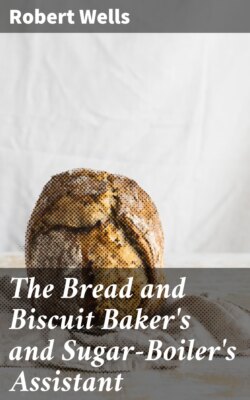Читать книгу The Bread and Biscuit Baker's and Sugar-Boiler's Assistant - Robert Wells - Страница 9
Brown Bread.
ОглавлениеWith regard to the nutritive qualities of brown bread, Professor Jago (who I think one of our highest authorities) says that whole meal, and flour from which the bran and germ have not been removed, do not keep well. These bodies contain oil and nitrogenous principles which readily decompose, producing rancidity and mustiness in flavour. Not only do these changes occur in the flour, but they also proceed apace in the dough. The diastastic bodies of the bran and germ attack the starch, and more or less convert it into dextrine and maltose; they further attack the gluten, and that remarkably elastic body which confers on wheaten flour, alone of all the cereals, the power of forming a light, spongy, well-risen loaf. The gluten, under the action of the bran and germ, loses its elasticity, and becomes fragile and incapable of retaining the gas produced during fermentation; the result is heavy, sodden, indigestible bread.
Evidence of this is found in the fact that while whole-meal loaves are so excessively baked as to produce a crust two or three times the ordinary thickness, the interior is still in a damp and sodden condition. This is the effect of bran in whole-meal.
“Not only, then, on the ground of nutritive value may the use of a pure white loaf be urged, but such bread is more healthily made, and will be sweet and free from acidity when whole-meal and dark breads are sour and unwholesome. It has also been pointed out that the nutritive constituents of the bran are so locked within it that they escape unaltered from the human body.”
Such, in brief, is Professor Jago’s opinion of whole-meal, and bread made from it. My own opinion is that Darwin’s theory of the survival of the fittest is very forcibly illustrated in the milling of cereals, and the adoption of food most proper for the human system. We have had brown bread and white bread before the public from time immemorial, and what is the result? Why, for every sack of wheat-meal bread which is baked we have a thousand sacks of fine or white bread. And what of our hospitals and our army and navy, with medical men at the head of them, watching the results of this food or that food, and its effects on the human body? I admit that brown bread does suit some constitutions; but to the majority of people it is nauseous, frequently causing flatulency. I will just quote another good authority—Professor Charles Graham.
In his lecture upon “The Chemistry of Bread-Making,” delivered before the Society of Arts in December, 1879, he said: “As regards the importance of the constituents of bran, I say that the analyst, and the physician who makes use of the analyst as his supporter, in bringing before us the importance of brown bread as compared with white, and who assert that in rejecting the bran we are guilty of a serious waste of flesh-forming and bone-forming material, should not take a mere chemical analysis as all-sufficient to establish their point. A table showing, from an analyst’s point of view, the comparative merits of various substances for feeding purposes, shows hay to be of high value as a food, and even oat straw—as, indeed, every farmer knows from experience. Still more valuable for their heat-giving, and especially for their flesh-forming, materials, are linseed-cake, rape-cake, and decorticated cotton-cake. Now those who hold, from mere chemical analysis, that bran is of such high value as a food material that its omission from flour would meet with grave censure, should, from a similar analytical standpoint, urge us to eat hay, oat-straw, linseed and cotton cakes. Doubtless these substances are of high value as food for cattle, because the herbivorous oxen can digest and utilise them with ease; not so with man, who would starve in a field where a cow or a sheep would fatten. As with hay or linseed cake, so with bran; I hold that the best mode of digesting such food substances is first of all by the aid of our hoofed friends, to convert them into milk or cream, or bacon, beef, or mutton.”
Now these are the scientific opinions of two of our very highest authorities. But of late I have been making brown bread out of a blend of cereals made and milled by an enterprising firm of millers in the North of England, and I must really say that it meets a long-felt want, as it produces a brown loaf which is free from that nauseous taste of which complaint is so often made with brown bread, and has a good nutty flavour of its own.
In conclusion, let me say that we have reason for great hope for the future of the Bread and Confectionery trade. Many earnest minds are devoting both time and money to the development of this important industry, and their efforts cannot fail to result in bettering the knowledge and lightening the labour of the practical baker.
